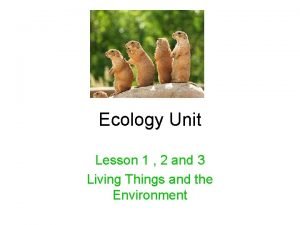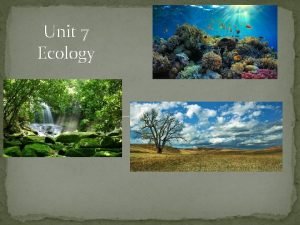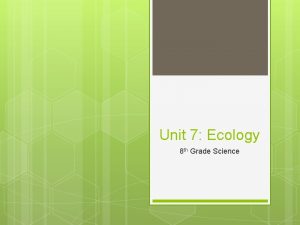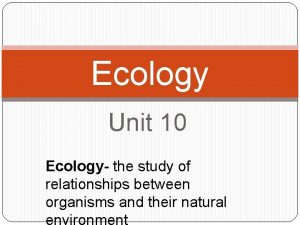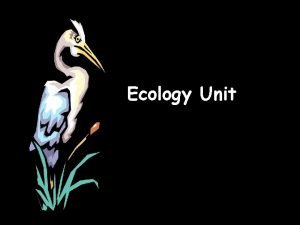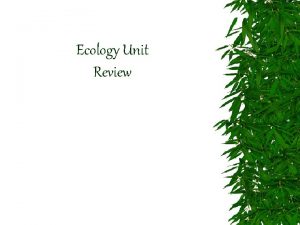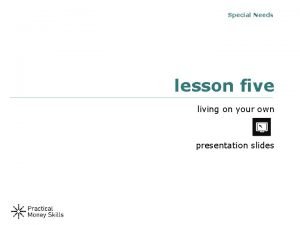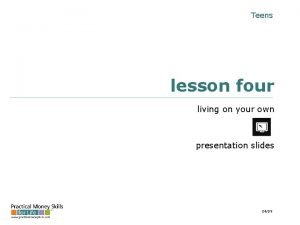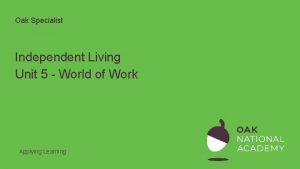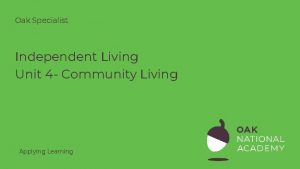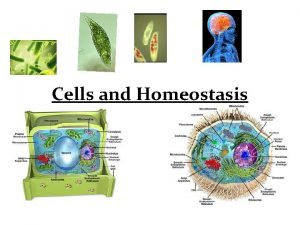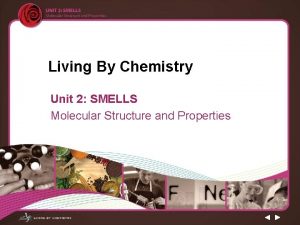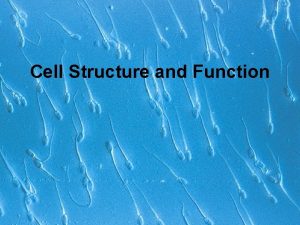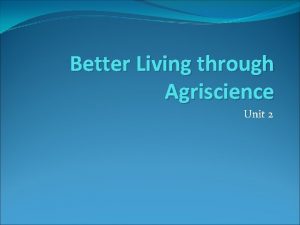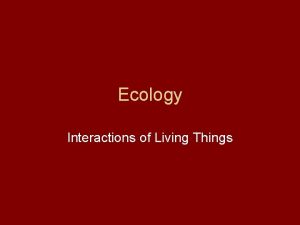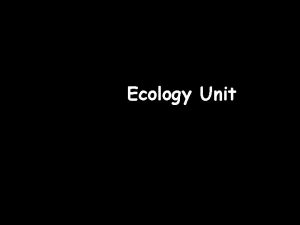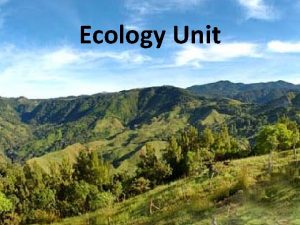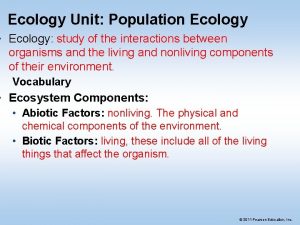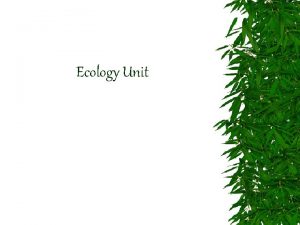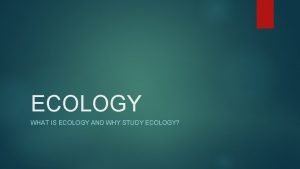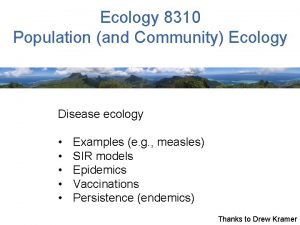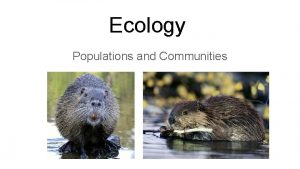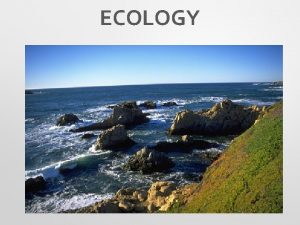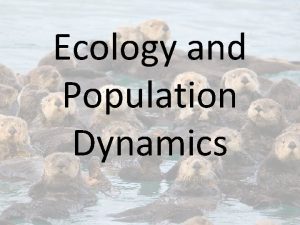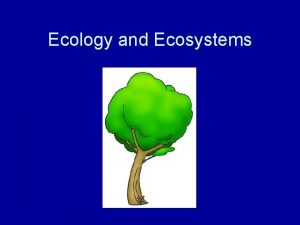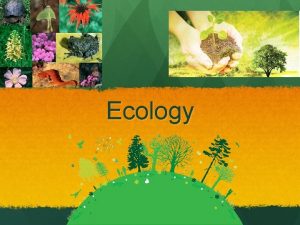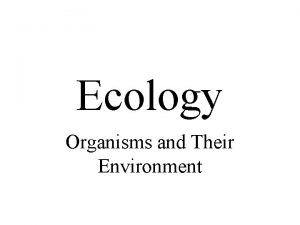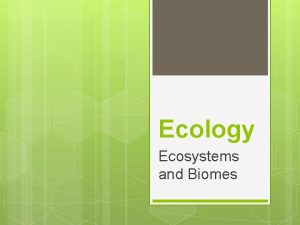Ecology Unit Lesson 1 2 and 3 Living


























- Slides: 26

Ecology Unit Lesson 1 , 2 and 3 Living Things and the Environment

Do Now Open your books to page 6 and take a picture walk through the chapter to page 10.

What do I need to know as I read? • What needs are met by an organism’s surroundings? • What are the two parts of an organism’s habitat? • What are the levels of organization within an ecosystem?

Chapter Vocabulary • In the back of your packet on the vocabulary page, write the following terms: Organism Habitat Biotic Factors Abiotic Factors Species Populations Community Ecosystem

Vocabulary check • Organism: any living thing • Habitat: an environment that provides the things the organism needs to live, grow, and reproduce. • Biotic Factors: the living parts of a habitat • Abiotic Factors: the non-living parts of an organism’s habitat – water, sunlight, oxygen, temperature, soil • Species: a group of organisms that are physically similar and can mate with each other to produce offspring • Population: All the members of a one species in a particular area • Community: all the different populations that live together • Ecosystem: the community of organisms that live in a particular area, along with their non-living surroundings

How are ecosystems organized? 1. Organism – one prairie dog 2. Population of Prairie dogs 3. Community of different organisms 4. Ecosystem- all living and nonliving things interacting on the prarie

Hierarchy of Ecosystems • In the diagram, where would you place… Organisms? Populations? Community? Ecosystems? • Organization of an ecosystem.

Ecosystem Organization Hierarchy Organisms Populations Community Ecosystems

Do Now • Using pages 6 -10, complete the workbook pages 47 -50 numbers 1 -18 • You may work in pairs if you choose to.

DO NOW • Get a book from the side. • Take your ecology packets out and open to last nights homework.

Let’s check our answers for 1 -18! 1. organism 2. Habitat 3. Needs food, water, and shelter 4. False 5. a, b, d 6. Biotic factors 7. Abiotic factors 8. Water, sunlight, oxygen, temperature, soil 9. a, c 10. Photosynthesis 11. b, d 12. A species is a group of organisms that can mate and reproduce offspring.

More answers! 13. A, b, c 14. False 15. Community 16. D 17. True 18. An ecosystem also includes abiotic factors

Do Now • Find pg. 51 in your packet. • Use the picture on page 11 to help you answer questions 1 -3 • Use your vocabulary page in the packet to help you answer #4 -8

Answers to Page 51 1. organism – population – community – ecosystem 2. a. ) Buffalo, grass, hawks, snakes, owls, flies b. ) water, soil, sunlight, oxygen, temperature c. ) Trees- hawks underground – worms prairie – buffalo water – fish 3. Ecology is the study of how organisms interact with their environment.

Lets Analyze an Ecosystem – pg 52 in packet • Biotic factors found in this picture: blue-jay, bear, dragon fly, frog, lizard, fish, squirrel, cattail plant, ferns, grass, trees • Abiotic factors found in this picture: warm temperatures, oxygen in the air, soil and rocks, sunlight, water • Habitats (homes of the animals) Bear – forest blue jay – trees, ground, sky squirrel – trees, ground Fish – water Lizard – ground, under rocks Dragonfly – weeds, sky, near water Frog – pond, stream, lake

Studying Populations Do Now • In the back of your packet on the vocabulary page, write the following new vocabulary words • Birth Rate • Death Rate • Immigration • Emigration • Population Density • Limiting Factors • Carrying Capacity

Reading the chapter • First, open your books to page 13. • Then, lets discuss your new vocabulary words. • Now, help me with a little demonstration…

Do Now • Get a Science book from the side. Using pages 13 -19, define the vocabulary words you wrote yesterday. rabbit

Vocabulary Check 1. Birth Rate: the number of births in a population in a certain amount of time 2. Death Rate: the number of deaths in a population in a certain amount of time. 3. Immigration: moving into a population 4. Emigration: leaving a population 5. Population Density: the number of individuals in a specific area – population density = number of individuals / unit area 6. Limiting Factors: an environmental factor that causes a population to decrease ( things like food, water, weather and space are limiting factors) 7. Carrying Capacity: the largest population an area can support.

Use the equation to see how many frogs are in 1 sq. meter Population density = # of individuals ---------Unit Area 5 meters

How to solve the problem X= 25 frogs • Count the number of x’s • Divide that number by the unit area which is 25 meters. ( 5 x 5) • Your answer should be 1 frog per sq meter.

Do Now Open packet to p. 58 • Fill in the missing information in your guided notes packet.

Do Now • Please get a science book and then get your homework out (worksheet pg. 58 in packet)

Page 58 Answers Take out your packet and open to page 58 5. Populations can change in size when new members are added or when members leave the population. 6. Through the birth of offspring 7. Birth Rate 8. Dying 9. Death Rate 10. False 11. B – moving into a population 12. A - Leaving a population 13. True 14. Limiting factors 15. food, water, space and weather are the limiting factors. 16. Carrying capacity 17. True 18. Frost can kill organisms, floods and hurricanes can wash away nests and burrows

Answers to Study Guide 1. 2. 3. 4. 5. 6. 7. Any living thing Environment Habitat Living – nonliving Alive (has the 7 characteristics of life) Any living organism Abiotic Factors – – – 8. Sun Water Oxygen Temperature Soil Levels of organization – – Species Population Community ecosystem

Answers to Study Guide organism, population, community, ecosystem • LEVELS OF ORGANIZATION • • • 1 a. Food, water, shelter 1 b. It would either leave or die 2 a. Biotic factors are the living things in an ecosystem and abiotic factors of the non living things in an ecosystem 2 b. sunlight, water oxygen, temperature and soil (SWOTS) 2 c. Without sunlight, there would be no plant life and we need plants not only for food but also for oxygen. Without water, no living organism could survive. It is essential for life. 3 a. Organism, population, community, ecosystem 3 b. A community because a community means all the different populations in an area living in the same ecosystem. 3 c. If one population decreases, another might also because they depend on one another food. For example, if the numbers of mice were low, then the hawks and owls would have a hard time finding food and their numbers could be in trouble too. • • •
 The smallest living unit of all living things is
The smallest living unit of all living things is Venn diagram of living and non living things
Venn diagram of living and non living things Is it living
Is it living Living non living dead
Living non living dead Right triangle trigonometry examples
Right triangle trigonometry examples Lesson 1 introduction to ecology answer key
Lesson 1 introduction to ecology answer key Unit 7 ecology
Unit 7 ecology Unit 7 ecology answer key
Unit 7 ecology answer key Which of the following tells you population density
Which of the following tells you population density Unit 10 ecology
Unit 10 ecology Ecology unit review
Ecology unit review Fatality
Fatality Unit 10, unit 10 review tests, unit 10 general test
Unit 10, unit 10 review tests, unit 10 general test Lesson four living on your own
Lesson four living on your own Lesson four living on your own
Lesson four living on your own Classifying living things lesson 1 answer key
Classifying living things lesson 1 answer key Independent living unit 5
Independent living unit 5 Independent living unit 4
Independent living unit 4 Independent living unit 3
Independent living unit 3 What is the smallest unit of a living organism?
What is the smallest unit of a living organism? Smallest living unit
Smallest living unit Independent living unit 5
Independent living unit 5 Living by chemistry unit 2 smells answers
Living by chemistry unit 2 smells answers What is the smallest living unit in the body
What is the smallest living unit in the body What is the smallest living unit
What is the smallest living unit Unit 2 better living through agriscience
Unit 2 better living through agriscience Independent living unit 1
Independent living unit 1





